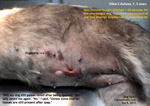Myths
Three dog owners told me today:
1. Dog at 5 years old, if neutered, will develop prostate cancer
2. Dog at 11 years old. Too old to neuter to prevent urine marking. I checked the health. Has heart disease now. So, anaesthesia not advised.
3. Dog, 4 years old. If spayed, will still get heat bleeding. "This is not possible," I said."Unless the vet leaves behind some ovarian tissue after spay."
I took over the spaying of this overweight Maltese X, at 9.15 kg, as Sunday is a busy day and I can spay faster, due to more years of experience. Still, I pray not to get fat dogs.
A. 10am Sedation with D + K at 50%. Dom = 0.18ml Ketamine = 0.23ml IV.
B. 10.28 am Isoflurane gas first given
C. 11 am Isoflurane gas stopped
D. 10.34 am First skin incision
E. 11.02 am Completion of stitching
Lots of oily fat. Hooked 2nd attempt.
10.42 am Left ovary hooked out
10.48 am Right ovary hooked out.
10.51 am Uterine body pulled out
10.55 am Uterine body ligated twice at 2 locations
10.56 am Linea alba stitched
11.02 am End of stitching.
12 noon Dog alert and goes home.

E-D = 28 minutes
E-A = 62 minutes (includes dental scaling before spaying). Therefore, excluding dental scaling, just for spay, E-A should be lesser.
SPAY TIPS FOR YOUNG VETS
1. The incision started 1.5 cm from the umbilical scar.
2. Ensure ovaries are exposed thoroughly including at least 5 mm of the ovarian suspensory ligament. Incise anteriorly 5mm more if you find difficulty in pulling out the ovary or can't access the suspensory ligament. In this dog, I was able to pull out the whole ovary and my finger could feel at least 5 mm of the suspensory ligament.
3. NICK INSTEAD OF RUPTURING THE SUSPENSORY LIGAMENT AS ADVISED BY THE PROFESSORS.
What to do with this suspensory ligament. I know the professors in the University may say "snap" it off with the finger by pulling hard to break it. The danger in fat dogs and small breed is that the force may break the whole ovarian ligament including the ovarian blood vessels, leading to profuse bleeding.
3.1 I use the scalpel blade and nick off the taut suspensory ligament on the dorsal side at around 2 mm depoth. A young vet asked me whether I would also nick off the ovarian blood vessels with the scalpel. My answer is no if you just nick at the taut ligament. You can feel it very tight when you pull out the ovary and at the tight area, use the scalpel to nick it. For big breeds, you can feel this tight ligament. I also nick it in big breeds.
4. TRANSFIXING SUTURE. The professors advise transfixing the uterine body. Now, the theory is great but in practice, the uterine body of a small breed like the Maltese or even this fat Maltese X Silkie is less than 8 mm in width. Transfixing ligature may rupture this uterine body as there is not much space. In this dog, I ligate the uterine body 2 times at 2 locations.
5. PROFUSE BLEEDING SEEN. If you incise the linea alba correctly and not the muscles, you seldom get profuse bleeding. I don't separate the omental fat surrounding the length of the uterine horn in this fat dog. Some vets will pull off the omental fat before ligating the uterine body and in big breeds, this may need to be done. In small breeds, I don't do it and ligate it together with the uterine body. Hence two ligatures at 2 locations. Profuse bleeding may come from omental blood vessels and it can be very alarming, as the body fills with flowing blood.
In cases where bleeding is non-stop, even when swabs are used, it is necessary to extend the incision to look for the bleeder and to save the dog from bleeding to death. There is no choice. Sometimes, the dog is on heat and the omental vessels are fragile and bleed easily. If the vet does NOT clamp the omental fat from the uterine horn area but just bursting it away with fingers before ligating the uterine body, there may be alarming profuse bleeding.
5. NO. OF SUTURE PACKETS
I used one packet of PDS 2/0. The last bit was to suture one horizontal mattress suture on the skin.
In conclusion, for the young vet, keep spaying simple by:
1. Making a large skin incision of over 4 mm. It is unlikely you can do a 2 cm incision and so don't try till you know the best location.
2. Try not to use fanciful stitching. Simple interrupted stitches x 3 (in this dog where the linea alba is around 2.5 cm long) and one horizontal mattress suture for the skin. No subcuticular or hidden sutures to impress the owner. Efficiency (short surgery, accuracy, speed and completion) rather than take your sweet time to do a spay.

 Toa
Payoh Vets
Toa
Payoh Vets